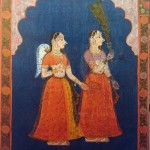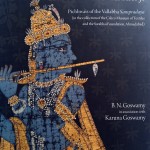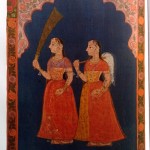SOMETHING ‘at the back’ or ‘behind’ is what etymology would suggest as the literal meaning of pichhwais but over several hundred years, the word has come to stand for those wonderful textile hangings —painted, embroidered, printed, machine-made — that are specific to the shrines of the Vallabha sampradaya, and hang in the homes of devotees.
- Standing in Adoration: A panel of pichhwai pata for a sacred image. Pigments on cotton. Rajasthan: Nathdwara, 19th century. Broad border with flowers and leaves on rich yellow ground
- Wondrous Images: Krishna seen as Shrinath-Ji Pichhwais of Vallabha Sampradaya (in the Collection of the Calico Museum of Textile and the Sarabhai Foundation) by B. N. Goswamy & Karuna Goswamy Sarabhai Foundation. Pages 248. Rs 3,250
- Standing in Adoration: A panel of pichhwai pata for a sacred image. Pigments on cotton. Rajasthan: Nathdwara, 19th century. Broad border with flowers and leaves on rich yellow ground
Krishna is at the heart of these textiles and there he stands, as he does in the celebrated temple at Nathdwara in Rajasthan, as beloved of all: left hand raised high, holding the great mount Govardhan aloft on his palm, to protect his kinsmen from the wrath of the God Indra. Krishna, of course, is the ‘Bearer of the Mountain’, but here he is known, and lives in the heart of his devotees, as Shrinath ji.
The sect has millions of devotees and they keep flocking to Nathdwara where darshans can be had, the most colourful of festivals are held all-year-long, music is always in the air, everyday Krishna’s costume is changed eight times in a day, the most subtle of delicacies are prepared to be offered to him.
The world there revolves around him, and only him. And everyone works for him: Priests and attendants, painters and musicians, masons and carpenters, tailors and cooks.
This wonderfully produced and written book is all about pichhwais, especially those that are in the Calico Museum of Textiles and the Sarabhai Foundation at Ahmedabad. But it is also about much else, to understand the world of the pichhwais involves many things: religion, history, literature, above all, feeling.
One has to know the great scholar and founder of the sect, Vallabhacharya; become acquainted with his son, Vitthalnath, who established the entire, exquisitely orchestrated, form of worship and ritual; trace the history of the sect; follow the round of festivals and celebrations.
But all this complex web is brought to life, with great ease and lucidity, by the two authors: First in their essay and then in the description of close to 100 pichhwais that appear in the book in full colour.
What stands out, over everything else in this book, is, however, the richness and texture of feeling that the book captures.
Consider this excerpt from a description of one of these magnificent picchwais, titled Standing in Adoration, two panels of which are pictured above.
Depicted in the textile are two women standing, holding flywhisks, one of peacock feathers and another of chamara/yak-tail.
The setting is architectural. They are standing under an arch, with a plain background. “The workmanship is delicate”, the text says, “the figures of the two young women lissom and elegant. They stand, wearing brief cholis and orhanis, wrapped over skirts, eyes filled with adoration.
“The colouring is simple — an arrangement of yellows and mauves — but it sits well in the soft grey ground. The flywhisks, one can see, are more symbols of service than objects of use, the chamara, in fact, idling on the shoulder of one of the women as she stands with one hand lightly extended as if intending to speak.”
The authors guide our gaze and make us look at the pichhwais almost with the same adoration as the two women — gopis, eternally in love with Krishna — do. An experience is brought within the reach of the viewer.
And for that one feels grateful.
Wondrous Images: Krishna seen as Shrinath-Ji: Pichhwais of Vallabha Sampradaya (in the Collection of the Calico Museum of Textile and the Sarabhai Foundation) by B. N. Goswamy & Karuna Goswamy, published by Sarabhai Foundation. Pages 248. Rs 3,250 was reviewed by Roopinder Singh in the Spectrum section of The Tribune on August 31, 2014.



